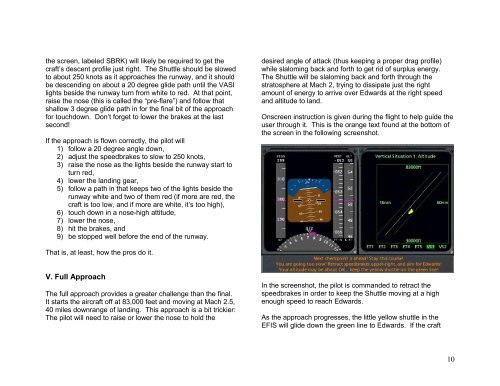Space Shuttle and Apollo manual - X-Plane.com
Space Shuttle and Apollo manual - X-Plane.com
Space Shuttle and Apollo manual - X-Plane.com
You also want an ePaper? Increase the reach of your titles
YUMPU automatically turns print PDFs into web optimized ePapers that Google loves.
the screen, labeled SBRK) will likely be required to get the<br />
craft’s descent profile just right. The <strong>Shuttle</strong> should be slowed<br />
to about 250 knots as it approaches the runway, <strong>and</strong> it should<br />
be descending on about a 20 degree glide path until the VASI<br />
lights beside the runway turn from white to red. At that point,<br />
raise the nose (this is called the “pre-flare”) <strong>and</strong> follow that<br />
shallow 3 degree glide path in for the final bit of the approach<br />
for touchdown. Don’t forget to lower the brakes at the last<br />
second!<br />
If the approach is flown correctly, the pilot will<br />
1) follow a 20 degree angle down,<br />
2) adjust the speedbrakes to slow to 250 knots,<br />
3) raise the nose as the lights beside the runway start to<br />
turn red,<br />
4) lower the l<strong>and</strong>ing gear,<br />
5) follow a path in that keeps two of the lights beside the<br />
runway white <strong>and</strong> two of them red (if more are red, the<br />
craft is too low, <strong>and</strong> if more are white, it’s too high),<br />
6) touch down in a nose-high attitude,<br />
7) lower the nose,<br />
8) hit the brakes, <strong>and</strong><br />
9) be stopped well before the end of the runway.<br />
desired angle of attack (thus keeping a proper drag profile)<br />
while slaloming back <strong>and</strong> forth to get rid of surplus energy.<br />
The <strong>Shuttle</strong> will be slaloming back <strong>and</strong> forth through the<br />
stratosphere at Mach 2, trying to dissipate just the right<br />
amount of energy to arrive over Edwards at the right speed<br />
<strong>and</strong> altitude to l<strong>and</strong>.<br />
Onscreen instruction is given during the flight to help guide the<br />
user through it. This is the orange text found at the bottom of<br />
the screen in the following screenshot.<br />
That is, at least, how the pros do it.<br />
V. Full Approach<br />
The full approach provides a greater challenge than the final.<br />
It starts the aircraft off at 83,000 feet <strong>and</strong> moving at Mach 2.5,<br />
40 miles downrange of l<strong>and</strong>ing. This approach is a bit trickier:<br />
The pilot will need to raise or lower the nose to hold the<br />
In the screenshot, the pilot is <strong>com</strong>m<strong>and</strong>ed to retract the<br />
speedbrakes in order to keep the <strong>Shuttle</strong> moving at a high<br />
enough speed to reach Edwards.<br />
As the approach progresses, the little yellow shuttle in the<br />
EFIS will glide down the green line to Edwards. If the craft<br />
10














